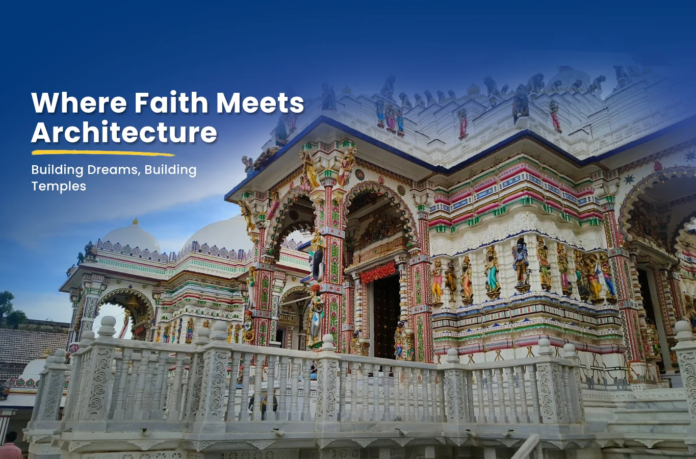Jain temples are renowned for their intricate designs, spiritual symbolism, and architectural brilliance. These temples, created by master craftsmen and architects, reflect the essence of Jain philosophy—simplicity, purity, and a commitment to non-violence. The contributions of a Temple Architect in India, especially from the Sompura community, have been instrumental in shaping these marvels. Across India, and particularly in Rajasthan, Jain temples stand as masterpieces that blend spirituality with artistic elegance.
The Architectural Philosophy of Jain Temples
Jain temples are designed to inspire tranquility and spiritual reflection. Their architecture adheres to specific principles derived from ancient texts, such as the Shilpa Shastra, ensuring harmony between form and function.
Emphasis on Intricacy and Symmetry
Jain temples are known for their intricate carvings, detailed sculptures, and symmetrical layouts. These features are not merely decorative; they symbolize spiritual ideals, such as balance and discipline, which are central to Jain teachings.
The Role of Sompura Architects in Jain Temple Construction
One cannot discuss Jain temples without mentioning the Sompura architects, a community that has specialized in temple construction for generations. Their expertise is evident in iconic temples such as the Dilwara Temples in Mount Abu and the Jain Temple Sompura in Rajasthan.
Hallmarks of Sompura Craftsmanship
- Marble Mastery: The use of white marble, intricately carved into delicate patterns, is a signature feature of Sompura-built Jain temples.
- Sacred Geometry: The Sompuras use precise geometric principles to ensure that every aspect of the temple aligns with spiritual and aesthetic ideals.
- Symbolism in Design: Elements such as domes, spires, and idols are placed according to religious significance, reflecting the Jain values of liberation and purity.
Unique Architectural Features of Jain Temples
1. Ornate Carvings and Sculptures
The walls, pillars, and ceilings of Jain temples are adorned with carvings that depict scenes from Jain mythology, floral motifs, and abstract patterns. Each carving is a work of art, showcasing the skill of the temple architects and artisans.
2. Pillared Halls (Mandapas)
Jain temples often feature large pillared halls, or mandapas, that are not only structurally significant but also artistically stunning. Each pillar is uniquely carved, adding to the grandeur of the temple.
3. Shikhara (Temple Spire)
The temple spires, or shikharas, symbolize the ascent towards spiritual liberation. Jain temples often have multiple shikharas, each representing a spiritual milestone.
4. Chaumukha Design
The chaumukha (four-faced) layout is a common feature in Jain temples, symbolizing the omnipresence of Tirthankaras (Jain spiritual teachers). The Ranakpur Jain Temple, with its 29 halls and 1,444 intricately carved pillars, is a prime example of this design.
Jain Temples in Rajasthan: A Blend of Art and Devotion
Rajasthan is home to some of the most magnificent Jain temples in India. The state’s thriving Temple Construction Service industry has played a crucial role in preserving and enhancing these structures.
Why Rajasthan is a Center for Jain Temples
- Abundance of Marble: Rajasthan’s high-quality white marble is a preferred material for temple construction.
- Skilled Craftsmanship: The region boasts artisans and architects with deep knowledge of traditional temple-building techniques.
- Historical Significance: Rajasthan has been a stronghold of Jainism, leading to the creation of numerous temples over centuries.
Modern Challenges in Preserving Jain Temples
While Jain temples are celebrated for their beauty, they face several challenges, including:
Restoring Ancient Structures
Many Jain temples, such as those built centuries ago by Sompura architects, require careful restoration to maintain their original splendor. This process demands expertise and a deep understanding of traditional methods.
Balancing Tradition with Modern Needs
Temple architects today must incorporate modern construction techniques and materials without compromising the traditional essence of Jain temples.
Environmental Sustainability
Given the emphasis on purity and non-violence in Jainism, architects are increasingly adopting eco-friendly practices in temple construction and restoration.
The Role of Temple Architects in Enhancing Jain Temple Heritage
The contribution of a Temple Architect in India extends beyond building structures. These architects act as cultural custodians, preserving the philosophy and artistry of Jainism through their work. Their designs inspire devotion, serve as centers of community gathering, and stand as monuments of India’s rich heritage.
Conclusion
The unique features of Jain temples in India, crafted by master architects like the Sompura community, highlight the harmonious blend of spirituality and art. With the support of skilled Temple Construction Service in Rajasthan, these temples continue to be awe-inspiring landmarks that attract devotees and art enthusiasts alike.
Whether it’s the intricate carvings, the sacred geometry, or the serene ambiance, Jain temples embody a timeless legacy. By preserving these architectural wonders, India safeguards not just its cultural heritage but also the spiritual essence that defines Jainism.


